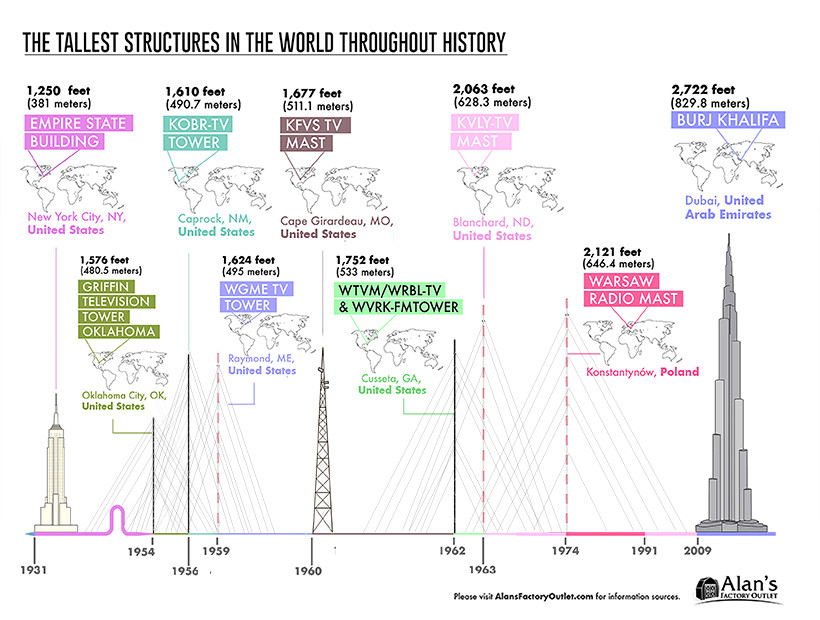These are the world's tallest structures throughout history

The Great Pyramid of Giza was the tallest structure in the world until 1221. Image: REUTERS/Goran Tomasevic
Humans have been building things since the dawn of time. As the tools and technology at our disposal have improved dramatically, so have the scale and magnitude of our creations.
Today’s infographic from Alan’s Factory Outlet visualizes some of the most impressive feats of construction and engineering in a historical timeline of the world’s tallest structures.
The Stone Age: 8000 — 2570 BCE
We’ll begin with one of humanity’s earliest stone monuments.
Experts estimate that the Tower of Jericho in modern-day Palestine, took 11,000 working days to construct—roughly 30 to 40 years—and is thought to have served as flood protection, and to mark the summer solstice. According to some archaeologists, it also inspired awe to “motivate people [into] a communal lifestyle”.

View the full timeline by clicking here.
The next significant structure was built nearly 4,000 years later. The Anu Ziggurat (White Temple) is located in Uruk, the ancient city of Sumer. Towering over the city’s defensive walls and visible from afar, it symbolized the city’s political power at the time.
Egypt’s era of pyramids was ushered in with the Step Pyramid of Djoser. A few decades later, the founding pharaoh Sneferu is credited for the vision behind the three major Egyptian pyramids—the Meidum, Bent, and Red Pyramids of Dahshur. The different designs reflect both the engineering shortfalls and advancements experienced during their construction…eventually leading to the most monumental pyramid of all.
The Great Pyramid of Giza is the oldest of the ancient world wonders, and the only one that is still intact today. It weighs an estimated 6 million tonnes—and rising up at 481 feet (147 meters), it was unsurpassed as the tallest structure for thousands of years.
Cathedral Creation: 1221 — 1549 CE
The timeline below skips ahead over 3,000 years after the construction of the Great Pyramid, as the reign of cathedrals begins to take over, starting with the Old St. Paul’s Cathedral in 1221—which needed over 200 years to complete.

View the full timeline by clicking here.
The Lincoln Cathedral enjoyed its title of tallest structure for over 200 years, until the St. Mary’s Church in Germany was constructed. However, all three of these cathedrals suffered serious damage for some reason or another: towers or spires collapsed, the buildings caught on fire, or were struck by lightning.
From Churches to the Chrysler: 1569 — 1930
The construction of religious monuments continued well into the late 19th century, with the Cathedral of Saint Peter of Beauvais to the Cologne cathedral. Several cathedrals were originally constructed years prior, but only gained the title of tallest structure once the Great Pyramid had significantly eroded by about 33 feet (10 meters).

View the full timeline by clicking here.
The Washington Monument, the world’s tallest obelisk, was created in memoriam of the first U.S. President. Though the majority of the Monument is marble, its apex is aluminum and bears several inscriptions on each face.
The Eiffel Tower likely needs no introduction—the Parisian cultural icon became the tallest in the world in 1889. The wrought-iron lattice structure costed close to 8 million gold Francs, or US$1.5 million to build.
Finally, the Chrysler Building’s art-deco architectural style drew criticism and rave reviews in equal measure. Born out of a skyscraper boom in New York City, it was the first to rise above 1,000 feet—toppling the Eiffel Tower’s tallest title in 1930.
Bigger, Better, Glitzier: 1931 — Present
The “race for the sky” continues with the Empire State Building, an essential contribution to the classic New York City skyline—which cements its place as one of the seven wonders of the modern world.

View the full timeline by clicking here.
Between 1954 and 1991, the tallest man-made constructions were all TV towers, mostly located across the United States, and the Warsaw Radio Mast in Poland. That’s not to say there was a gap in skyscrapers during this time—in fact, it was quite the opposite all around the world.
Saving the best for last, the Burj Khalifa was completed in five years and costed a whopping $1.5 billion. At an impressive 163 floors (2,722 feet or 830 meters), Dubai’s incredible achievement shatters all world records for tallest structures—coming in at nearly 100 times higher than the Tower of Jericho, where this visual timeline first began.
Don't miss any update on this topic
Create a free account and access your personalized content collection with our latest publications and analyses.
License and Republishing
World Economic Forum articles may be republished in accordance with the Creative Commons Attribution-NonCommercial-NoDerivatives 4.0 International Public License, and in accordance with our Terms of Use.
The views expressed in this article are those of the author alone and not the World Economic Forum.
Stay up to date:
Cities and Urbanization
Related topics:
Forum Stories newsletter
Bringing you weekly curated insights and analysis on the global issues that matter.







